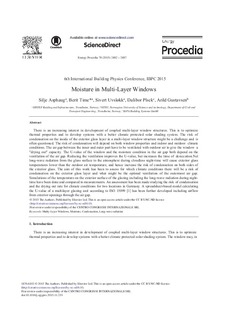| dc.contributor.author | Korsnes, Silje Kathrin | |
| dc.contributor.author | Time, Berit | |
| dc.contributor.author | Uvsløkk, Sivert | |
| dc.contributor.author | Plsek, Dalibor | |
| dc.contributor.author | Gustavsen, Arild | |
| dc.date.accessioned | 2016-01-08T12:16:48Z | |
| dc.date.accessioned | 2016-02-10T07:39:31Z | |
| dc.date.available | 2016-01-08T12:16:48Z | |
| dc.date.available | 2016-02-10T07:39:31Z | |
| dc.date.issued | 2015 | |
| dc.identifier.citation | Korsnes, S. K., Time, B., Uvsløkk, S., Plsek, D., & Gustavsen, A. (2015). Moisture in Multi-Layer Windows. Energy Procedia, 78, 2482-2487. doi:http://dx.doi.org10.1016/j.egypro.2015.11.233 | en |
| dc.identifier.issn | 1876-6102 | |
| dc.identifier.uri | http://hdl.handle.net/11250/2378661 | |
| dc.description | | |
| dc.description.abstract | There is an increasing interest in development of coupled multi-layer window structures. This is to optimize thermal properties and to develop systems with a better climate protected solar shading system. The risk of condensation on the inside of the exterior glass layer in a multi-layer window structure might be a challenge and is often questioned. The risk of condensation will depend on both window properties and indoor and outdoor climate conditions. The air gap between the inner and outer part have to be ventilated with outdoor air to give the window a "drying out" capacity. The U-value of the window and the moisture condition in the air gap both depend on the ventilation of the air gap. Reducing the ventilation improves the U-value, but increases the time of desiccation.Net long-wave radiation from the glass surface to the atmosphere during cloudless night-time will cause exterior glass temperatures lower than the outdoor air temperature, and hence increase the risk of condensation on both sides of the exterior glass. The aim of this work has been to assess for which climate conditions there will be a risk of condensation on the exterior glass layer and what might be the optimal ventilation of the outermost air gap. Simulations of the temperature on the exterior surface of the glazing including the long-wave radiation during nighttime have been done and compared to measurements. An assessment has been made studying the risk of condensation and the drying out rate for climate conditions for two locations in Germany. A spreadsheet-based model calculating the U-value of a multilayer glazing unit according to ISO 15099 [1] has been further developed including airflow from exterior openings through the air gap.
Keywords: Multy-Layer Windows; Moisture; Condensation; Long-wave radiation | en |
| dc.language.iso | eng | nb_NO |
| dc.publisher | Science Direct | en |
| dc.rights | Navngivelse-Ikkekommersiell-IngenBearbeidelse 3.0 Norge | * |
| dc.rights.uri | http://creativecommons.org/licenses/by-nc-nd/3.0/no/ | * |
| dc.subject | Multy-Layer Windows | en |
| dc.subject | Moisture | en |
| dc.subject | Condensation | en |
| dc.subject | Long-wave radiation | en |
| dc.title | Moisture in Multi-Layer Windows | en |
| dc.type | Journal article | en |
| dc.date.updated | 2016-01-08T12:16:48Z | |
| dc.subject.nsi | VDP::Technology: 500 | en |
| dc.source.pagenumber | 2482-2487 | nb_NO |
| dc.source.volume | 78 | nb_NO |
| dc.source.journal | Energy Procedia | en |
| dc.identifier.doi | 10.1016/j.egypro.2015.11.233 | |
| dc.identifier.cristin | 1308665 | |

